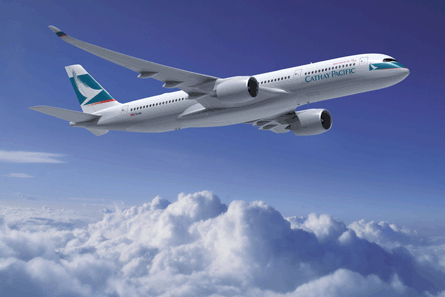After a summer dominated by talk of re-engining or replacing its narrowbody workhorse, Boeing's 777 widebody could move to the front of the clean-sheet queue, but blue chip customer Cathay Pacific's order for 30 300-seat Airbus A350-900s could shape the manner of the airframer's response.
Since the A350 XWB was launched in July 2006 after false starts for nearly two years in answer to the 787, Airbus has earned 535 firm orders for the A350, including 290 for the 314-seat -900 variant. By comparison, Boeing during the same period has added just 16 301-seat 777-200ERs. That number climbs to 37 with the inclusion of its ultra-long-range sister, the 777-200LR.
"Airbus clearly has the 777-200ER replacement market locked up, at least for now," says Richard Aboulafia, vice-president of analysis for the Teal Group.
According to its 10Q US Securities and Exchange Commission filing as of 30 June, Boeing holds 270 777s in backlog, or about three and a half years of production, versus nearly five years for the 2,007 737s yet to be built.
 |
|---|
© Airbus |
Boeing has largely discussed its 777 plans in terms of its future 365-seat 777-300ER, which earned an order from Cathay for six on top of its existing orders for 30. The -300ER is the largest, highest selling - and most expensive - version of the family, matched against Airbus's not fully defined A350-1000.
"There are few doubts that the -900 will be a very good plane, but for the A350-1000 Rolls-Royce needs to pull off a remarkable feat on Trent XWB execution. Yet even though we don't know much about the A350-1000's performance, Boeing needs to get going on something that matches it. The 777-300ER segment is enormously important to Boeing for volume and profit," says Aboulafia.
Although Boeing is hardly slowing down on its 777, with a boost in production to seven aircraft a month by mid-2011, the question remains about how to address the flagging -200ER sales.
Boeing has avoided pushing the 250- to 290-seat 787-9 into the 300-seat market, leaving Airbus to match its 270-seat A350-800 against the largest member of the 787 family, rather than take on the 314-seat A350-900.
However, the 787-9 could hold more potential to fill the role the 777-200ER holds, says the managing director of a lessor who has reviewed detailed dimensions of both aircraft. The leasing company says that the cabin lengths of both aircraft are nearly identical at around 49m (161ft), placing the 787-9 with nine-abreast seating and a range of 8,000-8,500nm (14,800-15,800km), nearly on par with the larger -200ER.
However, with firm configuration achieved in early July and 787-8 flight-testing still under way, "we'll have to wait and see about the 787-9's performance, but it might not quite match the A350-900", says Aboulafia.
Boeing plans a year-end decision on the future of the 777, and is studying a host of new features for its long-range twinjet, including new engines and a composite wing and fuselage, or even an all-new aircraft.
Although depending on the scope of the upgrades planned for 777, new logistical challenges could transform the supply chain, which in comparison to the smaller 787 today, is significantly less complex.
Spirit AeroSystems chief executive Jeff Turner says his company, which supplies the 777's aluminium forward fuselage, is evaluating different response scenarios that "depend on the material choices" Boeing selects for the 777.
If Boeing opts for a composite fuselage on the 777, Turner says Spirit does not have the manufacturing capacity and would "require a facilitisation plan" to support fabrication of seven composite 777 forward fuselages a month.
A single piece fuselage barrel with the 777's 6.2m width would require a new logistics system in a distributed supply chain, as Boeing's fleet of 747-400 Dreamlifter transports can only accommodate a fuselage no wider than that of a 787, at 5.8m.
"If they change material the supply chain has to adapt. Right now it's set up for the 787. If you get a second larger composite airplane in the supply chain, no- one has the capacity," says Ron Epstein, aerospace analyst for Bank of America Merrill Lynch, who adds: "There's all kinds of things [Boeing] can do." With its new South Carolina facility, for example, "they can start from scratch".
Source: Flight International























